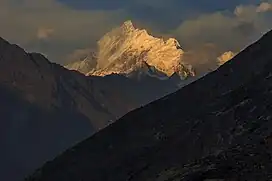| Malubiting مالونیتنگ | |
|---|---|
 Malubiting in 2017 | |
| Highest point | |
| Elevation | 7,458 m (24,469 ft) Ranked 58th |
| Prominence | 2,193 m (7,195 ft) |
| Listing | Ultra |
| Coordinates | 36°02′20″N 74°54′03″E / 36.03889°N 74.90083°E |
| Geography | |
 Malubiting مالونیتنگ Location in Gilgit-Baltistan  Malubiting مالونیتنگ Malubiting مالونیتنگ (Gilgit Baltistan) | |
| Location | Gilgit–Baltistan, Pakistan |
| Parent range | Haramosh Group of mountains, Karakoram |
| Climbing | |
| First ascent | 1971 by K. Pirker, H. Schell, H. Schindlbacher, H. Sturm |
| Easiest route | glacier/snow/ice climb |
| Malubiting | |||
|---|---|---|---|
| Traditional Chinese | 馬魯畢庭峰 | ||
| |||
Malubiting (Urdu: مالونیتنگ), also known as Malubiting West, ranks as the second highest peak is between Haramosh and Hisper valley within the Karakoram range in Pakistan. It is situated between Bilchar Dobani and Haramosh Peak, in the Gilgit-Baltistan region. Hisper Valley Nagar
Location
Malubiting is situated at the core of the Haramosh Group of Mountains, which tower over the northern bank of the Indus River. It is located approximately 50 km to the east of Gilgit, the principal town in the area. To the southwest, Malubiting ascends sharply above the Haramosh Jutial village along the banks of the Phuparash River, and to the east, the extensive Chogo Lungma Glacier originates from its slopes.
Climbing history
Malubiting was unsuccessfully attempted in 1955, 1959, 1968, 1969 and 1970 and 1971 before the first ascent in 1971. In that year an Austrian team led by Horst Schindlbacher reached the summit via the Northeast Ridge, ascending the North Peak and skirting the Central Peak on the way.
According to the Himalayan Index, there has been only one additional ascent, by a Swiss-German team in 1997, via the original route. (There may, however, have been other ascents that did not make it into the Index.)
Sources
- High Asia: An Illustrated History of the 7000 Metre Peaks by Jill Neate, ISBN 0-89886-238-8
- Orographical Sketch Map of the Karakoram by Jerzy Wala, 1990. Published by the Swiss Foundation for Alpine Research.
- Himalayan Index